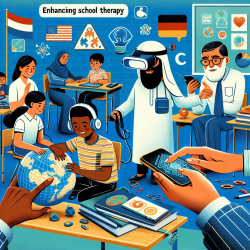Introduction
In the realm of speech-language pathology, understanding the social networks of children can be crucial for fostering effective communication skills and improving therapeutic outcomes. A recent study, "Religiosity is associated with greater size, kin density, and geographic dispersal of women’s social networks in Bangladesh," provides insights that can be translated into practical strategies for practitioners. By exploring how religiosity influences social networks, we can enhance our approaches to therapy, particularly in multicultural and diverse settings.
Key Findings from the Research
The study reveals that women with higher levels of religiosity tend to have larger social networks, characterized by a higher density of kin relationships. These networks are also more geographically dispersed, offering emotional support but not necessarily more financial or childcare assistance. This suggests that religiosity strengthens familial bonds and enhances emotional support within kin networks.
Implications for Speech-Language Pathologists
For speech-language pathologists, these findings underscore the importance of considering the social and cultural contexts of our clients. Here are some practical ways to apply these insights:
- Family Engagement: Leverage the strong kin networks of religious families by involving them in the therapeutic process. Encourage family members to participate in sessions and support communication goals at home.
- Cultural Sensitivity: Recognize the role of religiosity in shaping social interactions. Tailor your communication strategies to align with the cultural and religious values of the families you work with.
- Emotional Support: Utilize the emotional support inherent in these networks to reinforce therapy goals. Encourage families to provide positive reinforcement and practice communication skills in emotionally supportive environments.
Encouraging Further Research
While this study provides valuable insights, it also highlights the need for further research in different cultural contexts. Speech-language pathologists are encouraged to explore how religiosity and other cultural factors influence social networks and communication patterns in their own practice settings.
Conclusion
Incorporating an understanding of social networks influenced by religiosity can enhance therapeutic outcomes in speech-language pathology. By engaging families and recognizing the cultural dimensions of communication, practitioners can create more effective and personalized interventions for children.
To read the original research paper, please follow this link: Religiosity is associated with greater size, kin density, and geographic dispersal of women’s social networks in Bangladesh.










